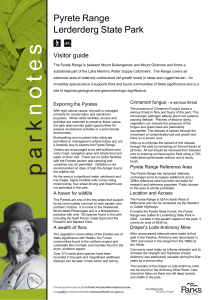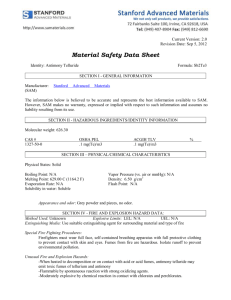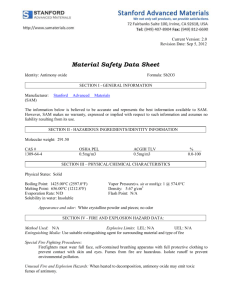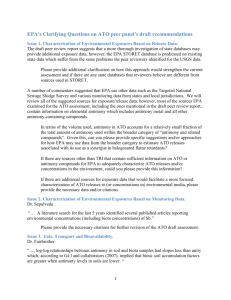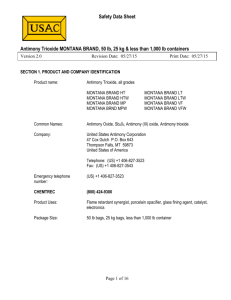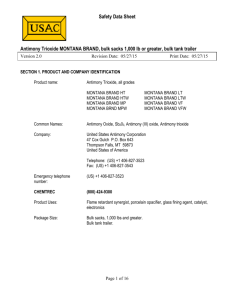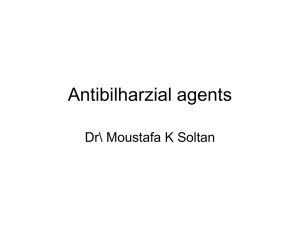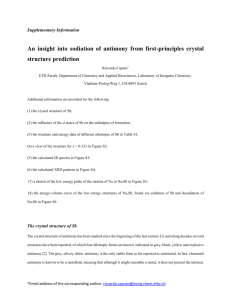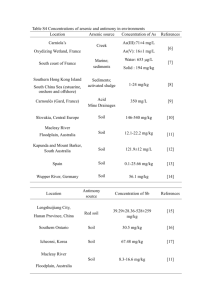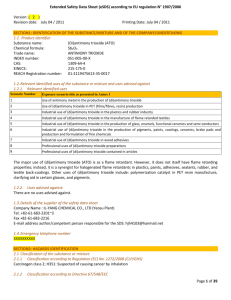(Independent) – Antimony Trioxide
advertisement
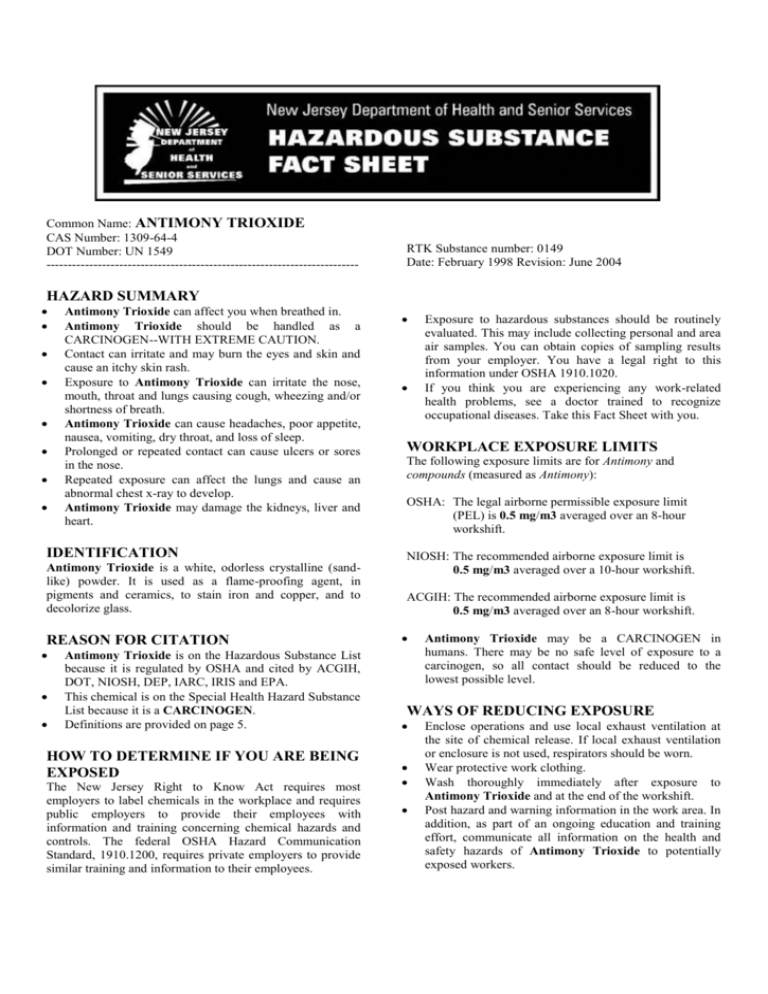
Common Name: ANTIMONY TRIOXIDE CAS Number: 1309-64-4 DOT Number: UN 1549 ------------------------------------------------------------------------- RTK Substance number: 0149 Date: February 1998 Revision: June 2004 HAZARD SUMMARY Antimony Trioxide can affect you when breathed in. Antimony Trioxide should be handled as a CARCINOGEN--WITH EXTREME CAUTION. Contact can irritate and may burn the eyes and skin and cause an itchy skin rash. Exposure to Antimony Trioxide can irritate the nose, mouth, throat and lungs causing cough, wheezing and/or shortness of breath. Antimony Trioxide can cause headaches, poor appetite, nausea, vomiting, dry throat, and loss of sleep. Prolonged or repeated contact can cause ulcers or sores in the nose. Repeated exposure can affect the lungs and cause an abnormal chest x-ray to develop. Antimony Trioxide may damage the kidneys, liver and heart. IDENTIFICATION Antimony Trioxide is a white, odorless crystalline (sandlike) powder. It is used as a flame-proofing agent, in pigments and ceramics, to stain iron and copper, and to decolorize glass. REASON FOR CITATION Antimony Trioxide is on the Hazardous Substance List because it is regulated by OSHA and cited by ACGIH, DOT, NIOSH, DEP, IARC, IRIS and EPA. This chemical is on the Special Health Hazard Substance List because it is a CARCINOGEN. Definitions are provided on page 5. HOW TO DETERMINE IF YOU ARE BEING EXPOSED The New Jersey Right to Know Act requires most employers to label chemicals in the workplace and requires public employers to provide their employees with information and training concerning chemical hazards and controls. The federal OSHA Hazard Communication Standard, 1910.1200, requires private employers to provide similar training and information to their employees. Exposure to hazardous substances should be routinely evaluated. This may include collecting personal and area air samples. You can obtain copies of sampling results from your employer. You have a legal right to this information under OSHA 1910.1020. If you think you are experiencing any work-related health problems, see a doctor trained to recognize occupational diseases. Take this Fact Sheet with you. WORKPLACE EXPOSURE LIMITS The following exposure limits are for Antimony and compounds (measured as Antimony): OSHA: The legal airborne permissible exposure limit (PEL) is 0.5 mg/m3 averaged over an 8-hour workshift. NIOSH: The recommended airborne exposure limit is 0.5 mg/m3 averaged over a 10-hour workshift. ACGIH: The recommended airborne exposure limit is 0.5 mg/m3 averaged over an 8-hour workshift. Antimony Trioxide may be a CARCINOGEN in humans. There may be no safe level of exposure to a carcinogen, so all contact should be reduced to the lowest possible level. WAYS OF REDUCING EXPOSURE Enclose operations and use local exhaust ventilation at the site of chemical release. If local exhaust ventilation or enclosure is not used, respirators should be worn. Wear protective work clothing. Wash thoroughly immediately after exposure to Antimony Trioxide and at the end of the workshift. Post hazard and warning information in the work area. In addition, as part of an ongoing education and training effort, communicate all information on the health and safety hazards of Antimony Trioxide to potentially exposed workers. ANTIMONY TRIOXIDE This Fact Sheet is a summary source of information of all potential and most severe health hazards that may result from exposure. Duration of exposure, concentration of the substance and other factors will affect your susceptibility to any of the potential effects described below. ------------------------------------------------------------------------- HEALTH HAZARD INFORMATION Acute Health Effects The following acute (short-term) health effects may occur immediately or shortly after exposure to Antimony Trioxide: Contact can irritate and may burn the eyes and skin and cause an itchy skin rash. Exposure to Antimony Trioxide can irritate the nose, mouth, throat and lungs causing cough, wheezing and/or shortness of breath. A metallic taste may occur. Antimony Trioxide can cause headaches, poor appetite, nausea, vomiting, dry throat, and loss of sleep. Chronic Health Effects The following chronic (long-term) health effects can occur at some time after exposure to Antimony Trioxide and can last for months or years: Cancer Hazard Antimony Trioxide may be a CARCINOGEN in humans since it has been shown to cause lung cancer in animals. Reproductive Hazard There is some evidence that Antimony Trioxide may damage the developing fetus and cause miscarriages. It may damage the male reproductive system and decrease the sperm count in animals. Other Long-Term Effects Prolonged or repeated contact can cause ulcers or sores in the nose. Repeated exposure can affect the lungs and cause an abnormal chest x-ray to develop. Antimony Trioxide may damage the kidneys, liver and heart. MEDICAL If symptoms develop or overexposure is suspected, the following are recommended: Any evaluation should include a careful history of past and present symptoms with an exam. Medical tests that look for damage already done are not a substitute for controlling exposure. Request copies of your medical testing. You have a legal right to this information under OSHA 1910.1020. Mixed Exposures Urine test for Antimony. Because smoking can cause heart disease, as well as lung cancer, emphysema, and other respiratory problems, it may worsen respiratory conditions caused by chemical exposure. Even if you have smoked for a long time, stopping now will reduce your risk of developing health problems. Because more than light alcohol consumption can cause liver damage, drinking alcohol can increase the liver damage caused by Antimony Trioxide. WORKPLACE PRACTICES CONTROLS AND Unless a less toxic chemical can be substituted for a hazardous substance, ENGINEERING CONTROLS are the most effective way of reducing exposure. The best protection is to enclose operations and/or provide local exhaust ventilation at the site of chemical release. Isolating operations can also reduce exposure. Using respirators or protective equipment is less effective than the controls mentioned above, but is sometimes necessary. In evaluating the controls present in your workplace, consider: (1) how hazardous the substance is, (2) how much of the substance is released into the workplace and (3) whether harmful skin or eye contact could occur. Special controls should be in place for highly toxic chemicals or when significant skin, eye, or breathing exposures are possible. In addition, the following control is recommended: Medical Testing For those with frequent or potentially high exposure (half the PEL or greater), the following are recommended before beginning work and at regular times after that: Chest x-ray and lung function tests. EKG. Liver and kidney function tests. Where possible, automatically transfer Antimony Trioxide from drums or other storage containers to process containers. Good WORK PRACTICES can help to reduce hazardous exposures. The following work practices are recommended: Workers whose clothing has been contaminated by Antimony Trioxide should change into clean clothing promptly. Do not take contaminated work clothes home. Family members could be exposed.
